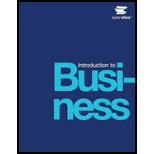
Introduction to Business
OER 2018 Edition
ISBN: 9781947172548
Author: OpenStax
Publisher: OpenStax College
expand_more
expand_more
format_list_bulleted
Textbook Question
Chapter 6.7, Problem 1CC
Define the basic managerial skills.
Expert Solution & Answer
Want to see the full answer?
Check out a sample textbook solution
Students have asked these similar questions
Subject. GENERAL ACCOUNT QUESTIONS
Can you help me solve this general accounting problem with the correct methodology?
I need help solving this general accounting question with the proper methodology.
Chapter 6 Solutions
Introduction to Business
Ch. 6.1 - Define the term management.Ch. 6.1 - What are the four key functions of managers?Ch. 6.1 - What is the difference between efficiency and...Ch. 6.2 - What is the purpose of planning, and what is...Ch. 6.2 - Identify the unique characteristics of each type...Ch. 6.3 - Explain the managerial function of organizing.Ch. 6.3 - What is the managerial pyramid?Ch. 6.4 - How do leaders influence other people's behavior?Ch. 6.4 - How can managers empower employees?Ch. 6.4 - What is corporate culture?
Ch. 6.5 - Describe the control process.Ch. 6.5 - Why is the control process important to the...Ch. 6.6 - What are the three types of managerial roles?Ch. 6.6 - Give examples of things managers might do when...Ch. 6.6 - List the five steps in the decision-making...Ch. 6.7 - Define the basic managerial skills.Ch. 6.7 - How important is each of these skill sets at the...Ch. 6.8 - How can information technology aid in...Ch. 6.8 - What are three principles of managing...Ch. 6.8 - Describe several guidelines for crisis management.Ch. 6 - Are top executives paid too much? A study of CEO...Ch. 6 - What type of manager is T.K. Kurien? How would you...Ch. 6 - What managerial role does T.K. Kurien assume in...Ch. 6 - What management skill sets does he exhibit?
Additional Business Textbook Solutions
Find more solutions based on key concepts
•• B.4. Consider the following linear programming problem:
Operations Management
An experimental composite engine block for an automobile will trim 20 pounds of weight compared with a traditio...
Engineering Economy (17th Edition)
Why is the capital-budgeting process so important?
Foundations Of Finance
The way to measure its net debt when calculating its unlevered cost of capital. Introduction: An interest tax s...
Corporate Finance (4th Edition) (Pearson Series in Finance) - Standalone book
Discussion Questions 1. What characteristics of the product or manufacturing process would lead a company to us...
Managerial Accounting (5th Edition)
Define cost pool, cost tracing, cost allocation, and cost-allocation base.
Horngren's Cost Accounting: A Managerial Emphasis (16th Edition)
Knowledge Booster
Similar questions
- Subject = General Accountarrow_forwardAccounting?arrow_forwardDriftwood Furniture Company implemented a new quality control system. Product approval requires: material inspection (40% weighting), structural testing (30% weighting), and finish quality (30% weighting). If a product scored 76 on material inspection, 82 on structural testing, and 68 on finish quality, your task is to identify the weighted quality score.arrow_forward
- I am trying to find the accurate solution to this general accounting problem with appropriate explanations.arrow_forwardBased on potential sales of 800 units per year, a new product at Eastwood Industries has estimated traceable costs of $1,440,000. What is the target price to obtain a 25% profit margin on sales? A. $2,400 B. $2,250 C. $2,000 D. $1,800arrow_forwardCan you help me solve this general accounting problem with the correct methodology?arrow_forward
arrow_back_ios
SEE MORE QUESTIONS
arrow_forward_ios
Recommended textbooks for you
 Understanding Management (MindTap Course List)ManagementISBN:9781305502215Author:Richard L. Daft, Dorothy MarcicPublisher:Cengage Learning
Understanding Management (MindTap Course List)ManagementISBN:9781305502215Author:Richard L. Daft, Dorothy MarcicPublisher:Cengage Learning Foundations of Business (MindTap Course List)MarketingISBN:9781337386920Author:William M. Pride, Robert J. Hughes, Jack R. KapoorPublisher:Cengage Learning
Foundations of Business (MindTap Course List)MarketingISBN:9781337386920Author:William M. Pride, Robert J. Hughes, Jack R. KapoorPublisher:Cengage Learning Foundations of Business - Standalone book (MindTa...MarketingISBN:9781285193946Author:William M. Pride, Robert J. Hughes, Jack R. KapoorPublisher:Cengage Learning
Foundations of Business - Standalone book (MindTa...MarketingISBN:9781285193946Author:William M. Pride, Robert J. Hughes, Jack R. KapoorPublisher:Cengage Learning


Understanding Management (MindTap Course List)
Management
ISBN:9781305502215
Author:Richard L. Daft, Dorothy Marcic
Publisher:Cengage Learning

Foundations of Business (MindTap Course List)
Marketing
ISBN:9781337386920
Author:William M. Pride, Robert J. Hughes, Jack R. Kapoor
Publisher:Cengage Learning

Foundations of Business - Standalone book (MindTa...
Marketing
ISBN:9781285193946
Author:William M. Pride, Robert J. Hughes, Jack R. Kapoor
Publisher:Cengage Learning